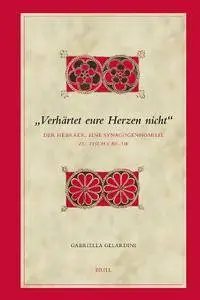'Verhartet eure Herzen Nicht': Der Hebraer, eine Synagogenhomilie zu Tischa be-Aw (Biblical Interpretation Series) (German Edition) by Gabriella Gelardini
German | 2006 | ISBN: 900415406X | 470 Pages | PDF | 2.28 MB
German | 2006 | ISBN: 900415406X | 470 Pages | PDF | 2.28 MB
This volume offers the first in-depth analysis of the literary structure of Hebrews against the background of its most frequently mentioned Sitz im Leben, the ancient synagogue. In the context of the liturgical year and its reconstructed cycle of readings, the text is newly interpreted on the basis of Exod 31:18 32:35 and Jer 31:31 34, so as to demonstrate that Hebrews was an ancient homily for the most important fast-day, Tisha be-Av, on which the destruction of the two temples was commemorated. The first part presents 20th- and 21st-century scholarship on Hebrews and a new structural analysis. The second part offers a detailed discussion of the ancient synagogue and its liturgy. This allows the reconstruction of the readings on which the text of Hebrews is based and a positioning within the liturgical year. The resulting thesis, that Hebrews is an exhortative homily for Tisha be-Av, is confirmed through a motivic analysis of all the biblical texts read on this fast-day. On the basis of the hermeneutical key thereby established, the third part offers seven cumulative readings of the entire text: structural, contextual, intertextual, rhetorical, theological, socio-historical, and hermeneutical-critical. These generate new interpretations and insights within the horizon of current Hebrews scholarship. The present monograph is the first to connect research on the ancient synagogue and its liturgy with a comprehensive interpretation of Hebrews that also discusses alternative form-critical avenues and establishes intertextual connections, especially to relevant rabbinic texts. The examination is directed not only to those with a specific interest in Hebrews, but also to scholars and students of the New Testament, Theology, Jewish Studies, and Religious Studies. ***** Der vorliegende Band bietet erstmals eine fundierte Analyse der literarischen Struktur des Hebraers vor dem Hintergrund seines meistgenannten Sitzes im Leben, der antiken Synagoge. Im Kontext des liturgischen Jahres sowie des rekonstruierten Lesezyklus wird die Schrift neu auf der Basis der Lesungen aus Ex 31,18 32,35 und Jer 31,31 34 als antike Homilie zum wichtigsten Fasttag von Tischa be-Aw, an dem der Zerstorung der beiden Tempel gedacht wurde, erschlossen. Die Untersuchung stellt im ersten Teil die Hebraerforschung des 20. und 21. Jahrhunderts sowie eine neue Strukturanalyse vor. Der zweite Teil fugt eine profunde Untersuchung der antiken Synagoge sowie der antiken Synagogenhomilie im liturgischen Kontext hinzu. Diese erlaubt die Rekonstruktion der dem Hebraertext zugrunde liegenden Lesungen und eine Positionierung innerhalb des liturgischen Jahres. Die resultierende These, dass der Hebraer eine mahnende Homilie zu Tischa be-Aw sei, wird im Rahmen einer Motivanalyse samtlicher zu diesem Fasttag gelesenen biblischen Texte bekraftigt. Im dritten Teil wird der gesamte Text auf der Basis des etablierten hermeneutischen Schlussels sieben kumulativen Lesungen unterzogen, einer strukturellen, kontextuellen, intertextuellen, rhetorischen, theologischen, sozio-historischen sowie einer hermeneutisch-kritischen. Diese generieren vor dem Horizont der aktuellen Hebraerforschung neue Interpretationsmoglichkeiten und Einsichten. Die vorliegende Monographie verbindet zum ersten Mal Forschungen zur antiken Synagoge und ihrer Liturgie mit einer koharenten Interpretation des Hebraertextes, die auch alternative formkritische Ansatze thematisiert sowie intertextuelle Bezuge insbesondere zu relevanten rabbinischen Texten benennt. Die Ausfuhrungen richten sich somit nicht nur an solche mit einem spezifischen Interesse am Hebraer, sondern auch an ForscherInnen und StudentInnen des Neuen Testaments, der Theologie, der Judaistik sowie der Religionswissenschaften."



